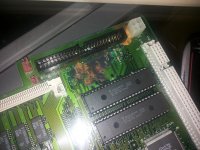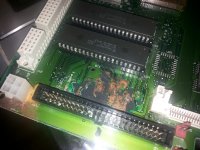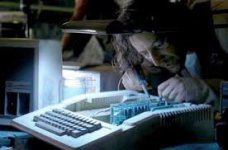Its fixable. Anything is. It depends on how much one is willing to throw in there. From what I can see, part of your ROM and much of your Internal SCSI port is affected here.
But if you do, it will be an act of love if you would do this. And here's how!
1 - You need to get a Butt Naked LC III Board and copy that area into a high resolution silk screening mesh.
Go into Photoshop and touch up a few things here and there before burning the mesh. Make it as a perfect square of the area as possible that it touches the traces around it.
2 - grind off a slightly smaller square area of the board and make it clean. De-populate the board off chips, caps and components Clean off the paint off the remaining traces and expose the metal under it.
3 - line up the LC III board to the silk screen and try it a few times, lifting it and putting it on the board to see if it remains in place and lined up perfectly. Secure the board down when you have it right.
4 - line up silk screen to the board and secure it.
5 - silk screen some conductive paint onto the board, give about 2 to 3 layers.
6 - remove silk screen and inspect work. If done perfect, allow conductive paint to cure, about 24 hours. If not, strip it off while its still wet with some strong paint thinners. Realign silk screen and repeat 3 - 6 if done wrong.
7 - put components back on the board. If its a good conductive paint, you should be able to solder on it. If not, there is a thing called "Cold Solder" which you can paint the parts back on and let it dry.
If all is done well, you have restored an LC III board.
Ad that's minor compared to what people do out there. People have been known to take this:
And turn it into this:







